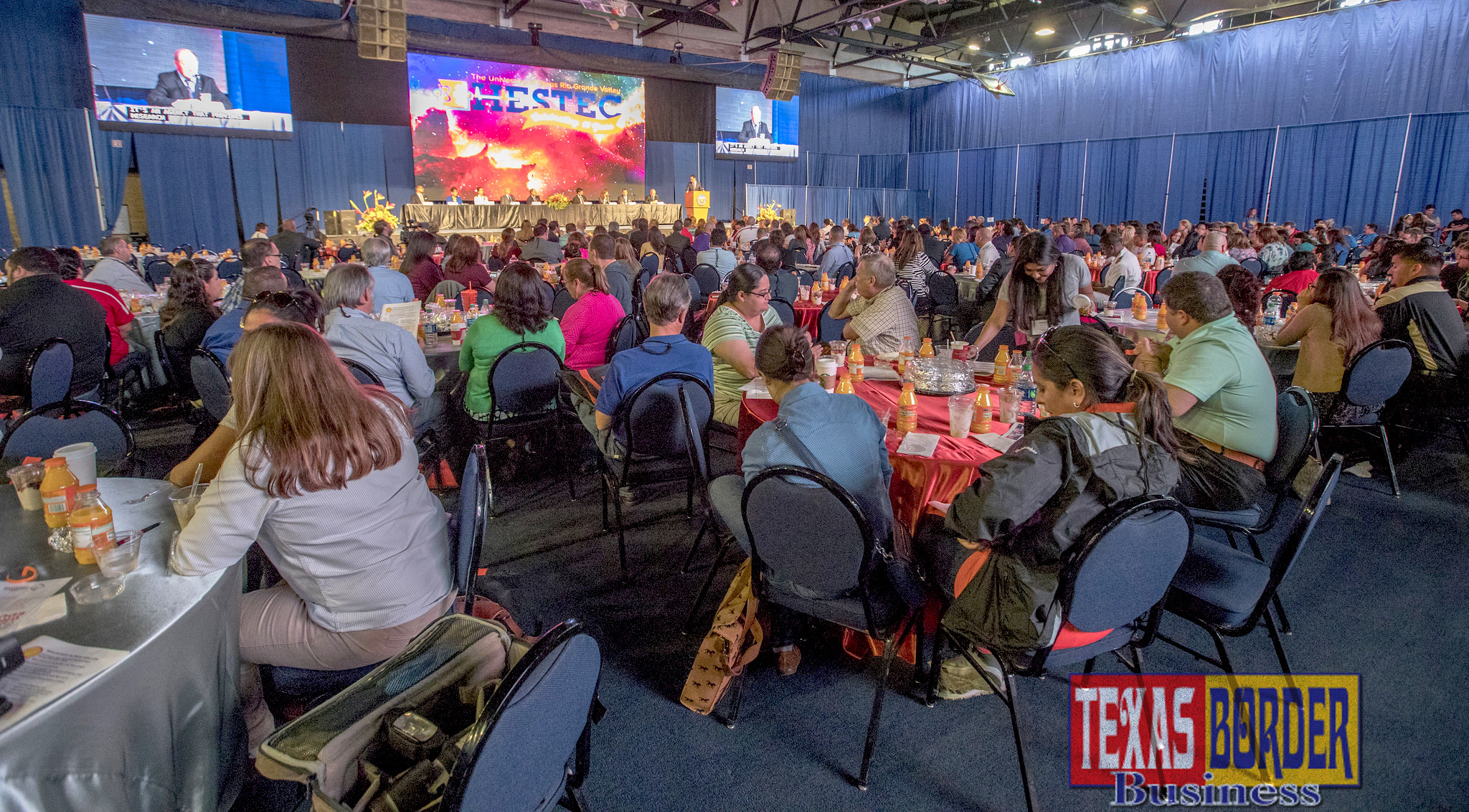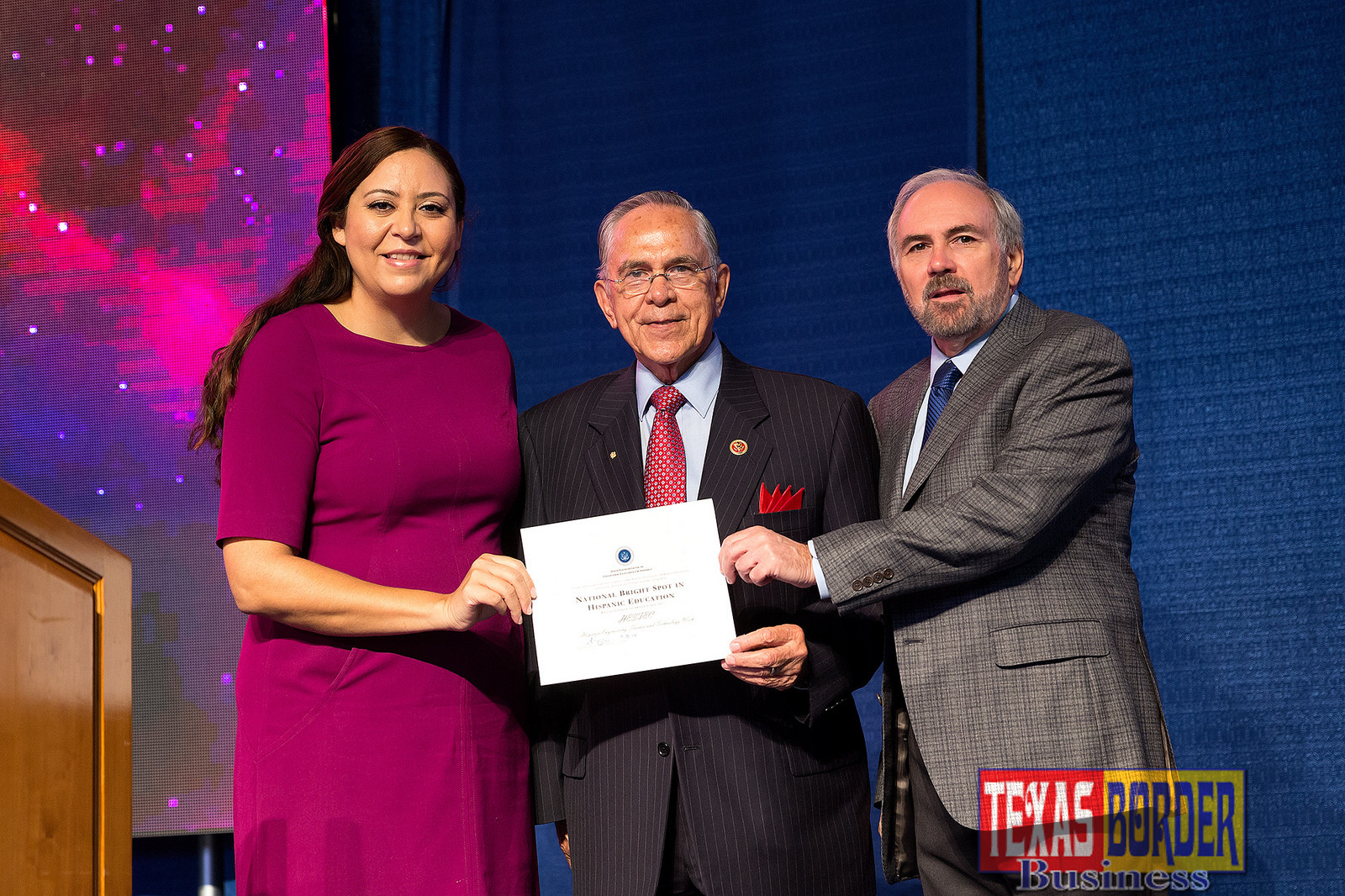
Texas Border Business
By Gail Fagan and Melissa Vasquez
EDINBURG, TEXAS – OCT. 3, 2016 – The University of Texas Rio Grande Valley opened HESTEC 2016 with a prestigious White House recognition of its 15 years of success in encouraging more students, particularly Hispanics and women, to take an interest in and pursue higher education and careers in STEM (science, technology, engineering and mathematics) fields.
Alejandra Ceja, executive director of the White House Initiative on Educational Excellence for Hispanics, represented President Barack Obama in presenting U.S. Rep. Rubén Hinojosa (TX-15) and UTRGV President Guy Bailey its 2015 Bright Spot recognition, which will be part of a national online catalog of more than 230 programs that invest in key education priorities for Hispanics.
Ceja thanked UTRGV, the Region One Education Service Center, other community partners, and particularly Hinojosa, who first conceived HESTEC in partnership with the university, for his leadership and service as a voice for the Latino community.
“Future generations will benefit from the legacy you leave here with HESTEC and your work for the people in your district,” she said.
Ceja said that last year there were more than 600,000 high tech jobs across the United States that were unfilled, and by 2018, 51 percent of all STEM jobs are projected to be in computer science- related fields. By the year 2022, she said, the United States will need about 1 million additional graduates in STEM fields to fill jobs in software development, biomedical engineering, computer system analysis and other technical fields.
“HESTEC is going to help us change that narrative,” Ceja said. “Today, I applaud the great investments you have made to create HESTEC, the Center of Excellence in STEM Education, stem-focused Early College High Schools, and robotics programs right here in South Texas that are preparing students for the jobs of the 21st century. People come from all over to the Rio Grande Valley to see the STEM opportunities that you all have made come true for students.”

CONGRESSIONAL PANEL ON STEM LITERACY
The opening day – Educator Day, sponsored by Shell – continued with a Congressional Panel on STEM Literacy moderated by José Díaz-Balart, Telemundo Network anchor.
Hinojosa and Bailey were joined on the panel by: U.S. Rep. Filemón Vela (TX-34); CDR Karen F. Muntean, U.S. Navy commanding officer; Dr. Vanessa Kertznus, subsurface lead – Mexico Ventures, Shell Exploration and Production Co.; Barry Cordero, interim CEO, Society of Hispanic Professional Engineers, on behalf of ExxonMobil; Dr. Robert Russell, program director, Education and Human Resources, National Science Foundation; Mario Lozoya, director, Government Relations and External Affairs, Toyota; and Dr. Marla Guerra, superintendent, South Texas ISD.
Participants discussed best STEM practices, including the importance of teachers and mentors in promoting and encouraging student success in STEM; establishing STEM pathways early in preK-12 education; maintaining a rigorous curriculum and high expectations of students; incorporating the family and hands-on learning opportunities in the child’s educational process; and increased collaboration between government, corporations and educational institutions in promoting and supporting STEM initiatives.
Educators were able to participate in a number of breakout sessions regarding STEM-related resources, initiatives and career opportunities. They also were able to take part in afternoon excursions to some of the area’s most popular, as well as least-known, STEM centers and facilities.
AND THE WINNERS ARE …
Also on Monday, ExxonMobil presented its HESTEC Educator Day 2016 Awards to four Valley high school teachers:
· Efren Rodriguez, science, Port Isabel High School, Point Isabel ISD.
· Robert Peynado, science, Lasara High School, Lasara ISD.
· Rebeca Gonzalez, mathematics, Port Isabel High School, Point Isabel ISD.
· Adina Garcia, mathematics, Veterans Memorial High School, Brownsville ISD.
“This is probably one of my favorite events that I do every year, and it’s because I know how special teachers are in the lives of students,” said Rosendo Cruz, a McAllen native and ExxonMobil program officer for education and diversity.
“That is one of the things that we do at ExxonMobil, we recognize and celebrate teachers,” he said. “I was with the chairman of our company recently, and we were talking about teachers and he said to me, ‘The outcomes are best achieved when you have great teachers. Teachers are at the center of improving societies and bettering the quality for life for everyone.’”
Each honoree received an all-expense paid trip to a national conference of their choice and a smart projector for their classroom.
FROM IMPROBABLY TO UNSTOPPABLE
A highlight of HESTEC Educator Day was Phoenix, Arizona, high school teacher Fredi Lajvardi, who told the inspirational story of how a group of underprivileged high school students defeated MIT to win a national championship title in 2004.
Lajvardi guided four students from Carl Hayden Community High School, who also were undocumented immigrants, in a university-level underwater robotics competition that they believed they had no chance of winning. Still, they went into it for the learning experience.
“We were going as an experiment to see what we could find out. We had no intentions of winning whatsoever,” Lajvardi said. “In hindsight, the kids were designing the robot without the intention of winning and I think that freed them up to take chances or risks … In taking those risks, you never know when one is going to pay off.”
The Falcon Robotics team persevered with its underwater robot, named “Stinky,” which was built on an $800 budget, and beat out their competitors for the Marine Advanced Technology Education National ROV Championships in Santa Barbara, Calif.
Their story inspired the film Spare Parts, which starred George Lopez, and Lajvardi showed a movie trailer to the Educator Day audience. In addition, a critically acclaimed documentary, Underwater Dreams, written and directed by Mary Mazzio and narrated by Michael Peña, documented the team’s journey and gave a glimpse of where they are now.
On the HESTEC agenda was a 6:30 p.m. Monday screening of Underwater Dreams at the UTRGV Edinburg Campus Student Union Theatre, with Lajvardi and his former student and robotics team member Lorenzo Santillán, on hand to talk about the film and share their stories.
Lajvardi, a high school teacher for 28 years, is program manager for the Marine Science Magnet Program at Carl Hayden and is the leader of the Falcon Robotics Team, which has gone on to win other national competitions in the field of robotics and inspired many other teams in Arizona and beyond.
“We went back two more years to that same competition. The second year, we finished third. The third year, we finished second. But here is the best part: All three years, we beat MIT,” Lavardi said.
The majority of his Falcon Robotics Team members over the years have gone on to college or the military, he said, and none has dropped out of college.
“If life doesn’t give you a dream … build one,” he told educators at the end of the day.














